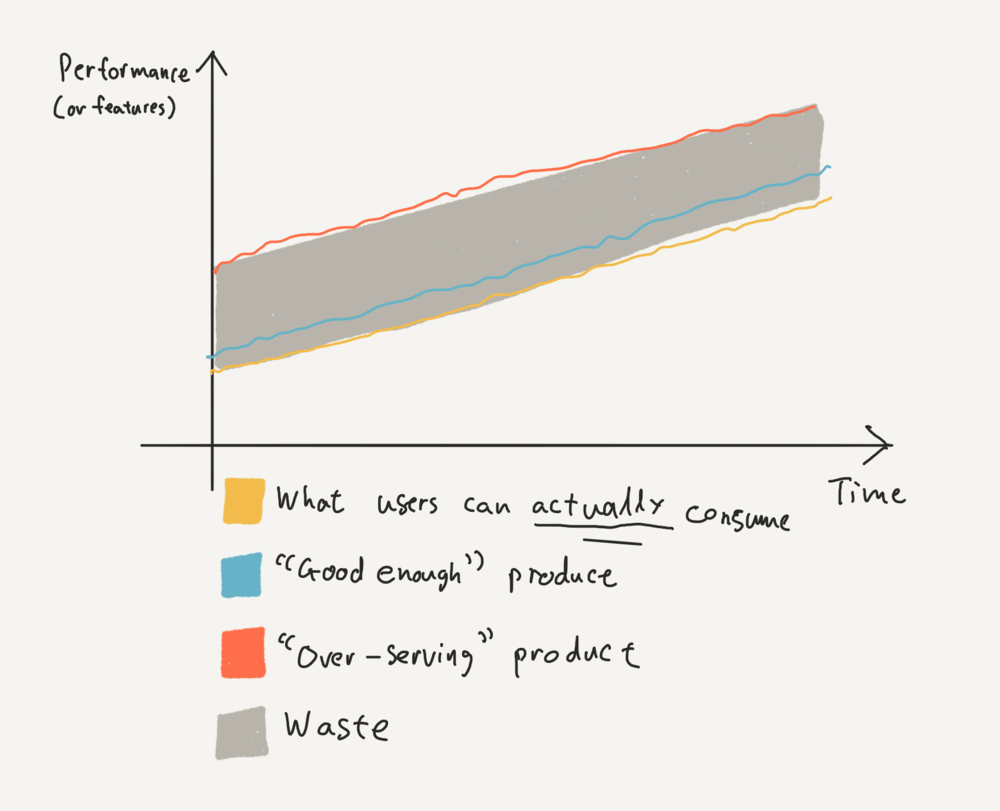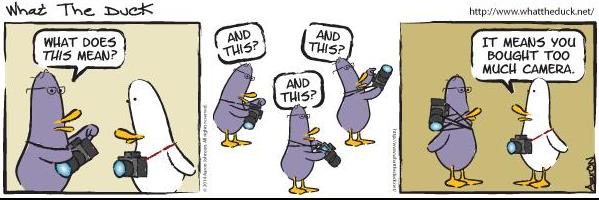2017 – When designing for “Good Enough” made Great Products
2017 was a great year for Video Games, Technology and Photography. One recurring theme that I noticed is that several successful products were designed to be “good enough” in particular performance metrics and as a result- be great at performing several “jobs-to-be-done”. Simply put, they follow the formula below:
Good enough(Performance Metric 1 + Performance Metric 2 + …) = Great at certain jobs-to-be-done
After reading several of Clayton Christensen’s books (The Innovator’s Dilemma and The Innovator’s Solution) and listening to Horace Dediu’s podcast, I’ve become a lot more aware of how companies tend to over-serve customers in their products to the point that the surplus of performance metrics cannot be consumed. This leads to waste in R&D, build and operational resources, basically a waste of human capital.

Over-serving products have been optimised well beyond what a user can consume.
In the process of product design and development, it’s important to know when your product performs a job-to-be-done to a good enough metric. This allows you to devote the team’s attention to making sure it performs the next job-to-be-done to a good enough standard. Here are some of the products in 2017 that I think have fit the bill.
Video Games
Nintendo Switch
If you grew up in the 90s like I did, then you’d have the impression that all that each new generation of video game consoles brought was graphics that brought us yet another step towards to the uncanny valley. One could argue that the main difference between Grand Theft Auto: San Andreas on the PlayStation 2 and Grand Theft Auto V on the PlayStation 4 Pro (aside from higher resolution graphics) are denser foliage and NPCs. The gameplay essentially remained the same.
Console video gaming became about more appreciating the increase in production value and less about advancing gameplay.
What Nintendo did with the Switch was brave and brilliant. They recognised that mobile SOCs (The Tegra X1 to be specific) had approached a point where “good enough” graphics muscle and power efficiency converged. The Nintendo Switch is not the first portable game console to feature a TV output, the Sony PlayStation Portable had that feature years ago. It is, however, the first one to have the horsepower to produce good enough graphics for a big screen TV.
The Switch’s killer feature however, is portability. Nintendo pulled off another clever balancing act in terms of design tradeoffs here. Let’s look at a few of these:
- Size vs Immersion: It isn’t as small as a 3DS or PlayStation Vita and nowhere as big as a full sized iPad. By designing around the 7” 720p display, it strikes a great balance of portability, immersion and performance. Good enough to fit in my work bag, good enough to immerse me outdoors.
- Battery life vs Performance: 3 – 4 hours is all you get with the switch. Anecdotally I’ve found that it’s great enough for use in real life. More than enough for daily commutes. On long-haul flights, plug it into a PowerBank while you’re playing or are interrupted by in flight meals. Good enough to keep me entertained on my commute.
- Focus on socially-engaging local multiplayer vs Focus on single player: If you’ve used the Joycons, you’ll know that they were never designed to be the best single player controller on a portable system. They were designed to be detached from the device and be used by two or more players locally. It seems obvious in hindsight, but as a designer myself I can say that this was an incredibly brave decision to make, especially when the compromises are glaring for certain users. The positives however, cannot be understated. Engaging, in-person multiplayer in video games have largely given way to “solo” multiplayer experiences. For working adults, the former fulfils a social need that the latter simply cannot. It’s not a wonder that you hear anecdotes of office workers having fun with their colleagues over Mario Kart during their lunch breaks. Good enough to be a single player controller, good enough to be two player controllers.
The rewards for taking such risks with the design? A user base with a much greater purchasing power compared to their previous consoles. Look at the demographics of Nintendo Switch buyers in the US. A staggering 63% of them are aged 24 and above. Nintendo’s consoles aren’t optimised for kids anymore.
I don’t think the Nintendo Switch is perfect by any means. In the next point below, I wonder how a dedicated gaming console can possibly compete with a phone or tablet that gets outfitted with a more powerful processor each year. Nintendo’s digital pricing strategy is also ludicrous, you’ll find games selling for higher prices on Nintendo’s eShop regularly compared to physical copies on Amazon.
For now, I would wager that because of the design decisions above, it doesn’t (need to compete on similar metrics). The Switch has good enough differentiating factors to distinguish itself from the iOS and Android devices that get updated every year, and thus can warrant a spot in a casual gamer’s arsenal of gaming gear.
Good enough(Portability + Battery Life + Performance + Local Multiplayer) = A great console can entertain me and my friends wherever I go.
Brilliant AAA Ports to iOS
It has always frustrated me that ports of AAA titles have always eluded iOS as a platform. In the phone that fits in your pocket, there is a processor that outperforms certain laptops, a display that has a higher resolution than most TVs and a Taptic Engine that offers more precise haptics than an Xbox or PlayStation controller. Where are the AAA games?
Sony tried to position their PlayStation Vita as a console that could offer AAA gaming on the go, but smartphones and tablets have their SOCs upgraded almost every year. Is there really much sense in building games AAA games for a piece of hardware that is supposed to fulfil a 10-year lifespan?
Of course, we know that the main reason why most developers are releasing patronising ports on iOS is the fear that they will not be able to charge a high enough price to make a decent profit.
Allow me to postulate though, release a good enough AAA port and they will come. This year has been very encouraging with the release of Life Is Strange, Civilization VI and Grid Autosport, all of which are full ports of their PC/Console counterparts that give you the entire content a one time purchase. As someone who uses “sitting down” time to create content rather than consume it, I greatly appreciate being able to consume AAA games during my “on-the-go” time.
All of these games don’t have the graphics cranked up to 11 or very precise controls, but they are tweaked to be good enough for almost console (or PC in Civilization VI’s case) quality gaming on the go. You might not be experiencing these games just as they get released, but when your time is more important than being the first to play a video game, it’s a worthwhile compromise to make.
Good enough(Playability on the go + Graphics + Controls) = Great gaming experience that I would have otherwise missed out.
PUBG and its clones shows the power of “good enough” gameplay
PlayerUnknown’s Battlegrounds (PUBG) just passed 30 million players as of the time I’m writing this piece. Starting out as a modification of ARMA II (a far less popular game), this game literally came out of nowhere to be one of the year’s most popular titles. Much of its success can be attributed to its addictive pacing, despite its “bland aesthetics and being prone to hiccups”.
What is more interesting however, are its clones on mobile. One of PUBG’s unofficial clones on iOS and Android is called “Rules of Survival” and sits on the number 1 spot in Top Free Games on the iTunes chart as of this time of writing. I’ve played this with friends extensively for over a week and can tell you that it’s one of the buggiest games I’ve ever played. Yet we keep coming back to it over and over again, both in face-to-face gatherings and remotely from the comfort of our homes.
Despite its less than stellar graphics, animations and bugs, it gets the job done when fulfilling a need of social engagement. Being dropped onto an island with a group of friends and having to survive Battle Royale style calls for a lot of teamwork. As an added bonus, most male citizens where I come from have some experience in the army, and being able to apply some of those tactics we’ve learned gives us a steady stream of endorphins whenever we see them playing out.
You know how it is with old friends. You used to spend a lot of time together engaged in a tough but rewarding form of teamwork that disappeared when you moved on. This is one way of reliving them.
Good enough(Graphics + Voice Chat + Cooperative gameplay) = Great team experience for old friends to bond over.
Technology
Apple AirPods
I’ve stuck the AirPods in my ears daily for just over a year now. As I mentioned in my long term review, it doesn’t have the best sound quality but fixes so many pain points with the current state of wired and bluetooth headphones that it’s almost a no-brainer if you own an iOS device (assuming you belong to the 80% of the population whose ears it will fit).
Good enough(Battery life + Sound Quality + Comfort + Ease of switching between devices ) = Great audio funnel into my eardrums, all day long.
Apple’s iPad (2017)
The beginning of this year also saw a new iPad called just that, the iPad. This was clearly designed to be a “good enough” iPad for content consumption from the start. It also hit a price point of US$329, low enough for people who just want an iPad that’s “good enough” to browse the internet, access their e-mails, view their photos and play some games.
Apple did a fantastic job designing the A9 processor in this iPad back in 2015. This processor was clearly designed to last several years to come, supporting core frameworks such as ARKit and hardware decoding of 8/10-bit HEVC. Plainly speaking, this means that you will be able to access many apps using these state-of-the-art technologies for years to come.
Good enough(Performance + Price + Future-proofing) = Great window to consume content.
Photography
Fujifilm X-E3 and X-T20
The job-to-be-done of the standalone camera has evolved over the past decade. It is no longer a tool to document family memories for posterity, the smartphone has displaced the standalone camera by its outstanding performance in portability. Simply put, the smartphone is better at being the camera that is always with you than the standalone camera can ever be.
What, then is the role of a standalone camera in 2017?
I’ve personally observed that one of the jobs that it is meant to fulfil with first time buyers is an aspirational one to stand out from the pack when it comes to sharing their documented moments. Modern smartphones have fantastic cameras for their size, but you’re often limited when it comes to low light shots (most award winning shots are taken during magic hour, before sunrise and sunset). You’re also limited to the one (or two) lenses on the phone, making your photograph’s field of view the same as the billions of other phones out there.
Another job that it fulfils is one of vanity. A standalone camera system is often worth hundreds, or even thousands of dollars. Yet walk around any tourist spot and you’ll inevitably see these systems slung around every other person’s neck. Coupled with the recent popularity of vintage style designs applied to modern cameras, the standalone camera system has become a competent retro-chic fashion accessory.
The other job that it fulfils is to serve as a “creative outlet” for photography hobbyists. This one is a bit more timeless. As good as the camera is, hobbyists often run into the limitations of their smartphone cameras very quickly and find themselves in need of a better system that allows them to achieve their creative aspirations. Much of these limitations are often self-rationalised, but that is not the point here. These limitations lead the hobbyist in the pursuit of a better photography system that they can learn to exploit during their spare time.

Do you know a hobbyist? (Credit: www.whattheduck.net)
When someone comes to me for recommendations for a standalone camera system in 2017, I’ve always directed them to the Fujifilm X-T20 or X-E3. Both have the same APS-C sensor that will differentiate image quality well enough from any smartphone. Both have enough advanced features (such as a sophisticated AF system) that will keep hobbyists occupied for years. Both have a retro-inspired design that will set itself apart from traditional DSLRs. Most importantly though, both produce very pleasing film simulated colours to your taste – out of the camera. The level of effort required between shooting a photograph and having it good enough to share is going to be minimal with these two cameras.
Good enough(JPEGs out of camera + Beautiful Design + Features for Hobbyists to learn) = Great first standalone camera system
Apple’s iPhone X
I recently took the iPhone X on a vacation to Italy and was blown away by how the entire package performed when it came to pocketable photography. The entire system is really greater than the sum of its good enough parts.

Shot and edited on the iPhone X
Good enough(Stabilised 52mm lens + Out of camera HEIFs + Dynamic Range + Low Light performance + Pocketability) = Great photography package.
Great signs for Product Design to come
2017 has been a great year from the perspective of a product design observer. It’s clear that some corporations are seriously starting to optimise their products heavily for a set of carefully identified jobs to be done. Optimising a product consumes human capital. Optimising it beyond what is consumable by a user leads to a waste in human capital. It’s encouraging to see that more and more companies are shipping products that are “good enough to be great”.
Do you have any experiences with other products in 2017 that were great because they were designed to be “good enough”? Let me know in the comments below!

Just wanted to let you know I’m always a fan of considered writing, as well as products made by the heart. Often, it takes great leadership to pool together "good enough" parts to make a notable whole. People who craft parts often want to go above and beyond "good enough" and there is artistry in that, but the commercial world is a cruel cruel place!
You make a great point! Management’s job is to pick individual components such that the sum make a notable whole, and the role of the craftsman is to make each component the greatest it can be.